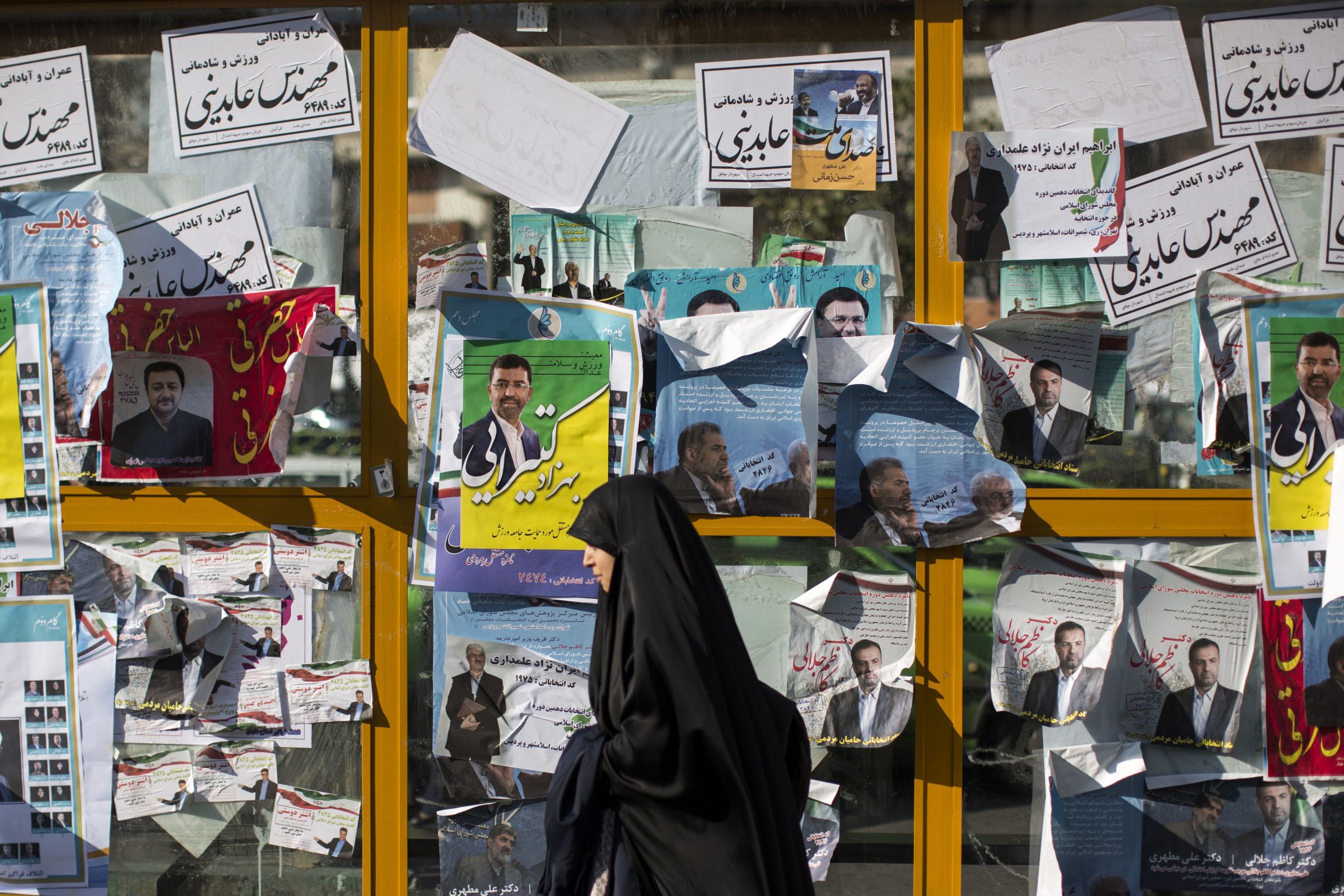
Iran heads to the polls this week for the first time since last July’s nuclear deal. But don’t expect this election cycle to transform the country’s political balance of power—that will come later. Here are the five facts you need to know about Iran’s key elections:
1. Assembly of Experts
There are two elections in Iran this week. The first is for the Assembly of Experts, a body made up exclusively of Islamic scholars serving eight-year terms and whose most important function is to elect the Supreme Leader. 801 individuals submitted themselves as candidates for the Assembly’s 88 available seats; only 166 of these people avoided rejection by the Guardian Council, the 12-person body charged with ensuring all legislation and candidates conform to Islamic and constitutional law. Nearly all moderate candidates were weeded out; all 16 women who applied were disqualified. The current Supreme Leader, Ali Khamenei, is 76-years old and long rumored to be in poor health; there’s a significant chance that his successor will be elected by the incoming Assembly. In many ways, the greatest battle for Iran’s future is in the Assembly—but the deck has been stacked against both moderates and reformers.
(The New York Times, Al-Monitor)
2. Parliament
The other election this week involves the 290-seat Majlis, Iran’s parliament. The Guardian Council vets candidates running for seats in parliament as well, but here it allows moderates a bit more leeway— Khamenei wants to let at least some air out of a public that wants change. More than 12,000 people registered to run for the Majlis. Of the 6,200-plus candidates who made the cut, as few as 100 are considered to be genuine would-be reformers.
Yet for the first time in many years, pragmatic candidates in Iran have wind in their sails. The nuclear deal, which is expected to provide a significant (and long-awaited) lift for Iran’s economy, remains broadly popular among the Iranian electorate; a poll conducted in January by the University of Maryland’s Center for International Studies found that 72 percent of Iranians approved of the nuclear agreement. Pragmatic conservatives, centrists and reformists, whom the public credits with getting that deal done and sanctions lifted, have a good chance to make modest gains in the Majlis, strengthening the moderate President Hassan Rouhani’s popular mandate.
(The Guardian, The Washington Post)
Read More: What a U.K. Exit from the E.U. Could Mean
3. Iran’s Economy
Plagued by double-digit unemployment and inflation for most of the past decade, Iran’s economy desperately needed the nuclear deal’s economic boost. Sanctions were lifted just a few weeks ago, allowing Tehran to unlock more than $100 billion in frozen assets. Since 2011, sanctions have cost Iran between 15 and 20 percent of its GDP and many of its best and brightest minds. Between 2009 and 2013, more than 300,000 Iranians left the country to look for work abroad. Some 25 percent of all Iranians with post-secondary degrees now live in other developed OECD countries. Lifting sanctions is expected to boost Iran’s GDP by at least 4 percent over the next 12 months. Perhaps a stronger economy will keep more of these talented people in the country—and lure back some of those who left.
(The Washington Post, Federation of American Scientists, Bloomberg, Al-Monitor, International Monetary Fund)
4. Iran vs. OPEC
Much of that GDP growth will come from the revival of Iran’s oil industry. In the first half of the 2015 fiscal year, oil accounted for 37.5 percent of Iran’s government revenues. Iran holds the fourth-largest proven crude oil reserves in the world, and its leaders plan to boost oil exports by an additional 1 million barrels a day by year’s end.
Iran’s revival also has implications beyond its borders, because its return to oil markets could not come at a worse time for other oil producers already facing a global supply glut. Russia and Saudi Arabia have proposed capping oil production at January 2016 levels to goose up the price of oil, but they would need the rest of OPEC—which includes Iran—to do the same. Fat chance; Iran’s oil minister called the proposal “ridiculous” this week. Iran will make up for lost time and export more oil, lower prices or not.
(Economist Intelligence Unit, US Energy Information Administration, The Washington Post)
Read More: Why a Scandal Won’t Stop Abenomics
5. Iran Opening
This week’s elections won’t bring the political sea change that outsiders are hoping for, but a decent showing by candidates broadly aligned with Rouhani’s agenda will help convince outsiders that Iran is open for business and a good bet for long-term investment. Over the past 20 months, more than 120 foreign business delegations have come to Iran in search of business opportunities. President Rouhani travelled to Europe earlier this year to meet France’s Francois Hollande and Italy’s Matteo Renzi to drum up foreign investment; he left with $30 billion in deals. Rouhani also intends to build tourism into a $30 billion-a-year industry by 2025.
All these moves will pay long-term dividends. They will also push hardliners and reformers toward an eventual showdown. At best, that’s just starting to emerge this election cycle. The winds of change have begun to blow in Iran, but they still need time to gather force.
(BuzzFeed, The Washington Post, Forbes)
Read More: These 5 Facts Explain the Debate Over Brexit
More Must-Reads from TIME
- Donald Trump Is TIME's 2024 Person of the Year
- Why We Chose Trump as Person of the Year
- Is Intermittent Fasting Good or Bad for You?
- The 100 Must-Read Books of 2024
- The 20 Best Christmas TV Episodes
- Column: If Optimism Feels Ridiculous Now, Try Hope
- The Future of Climate Action Is Trade Policy
- Merle Bombardieri Is Helping People Make the Baby Decision
Contact us at letters@time.com